
Diuris brumalis, commonly known as the winter donkey orchid, is a species of orchid that is endemic to the south-west of Western Australia. It is one of the first species of donkey orchid to flower in Western Australia each year and its flowers have been shown to attract the same insects that pollinate other species, but without offering a food reward.
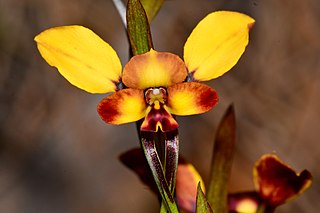
Diuris porrifolia, commonly called the small-flowered donkey orchid is a species of orchid which is endemic to the south-west of Western Australia. It has two or three leaves and up to seven yellow flowers with brown or reddish markings. It is similar to the common donkey orchid but its flowers are smaller and it has a more easterly distribution.

Diuris drummondii, commonly known as the tall donkey orchid is a species of orchid which is endemic to the south-west of Western Australia. It is the tallest Diuris and is distinguished from the similar Diuris emarginata by its larger, more widely spaced flowers. The flowers are pale yellow with brown markings.
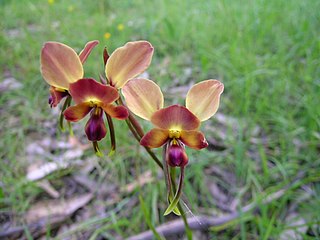
Diuris orientis, commonly called the eastern donkey orchid or wallflower donkey orchid, is a species of orchid that is endemic to eastern Australia. Like others in the genus Diuris, it has two ear-like petals and is similar to the common donkey orchid of Western Australia with which it has been confused. This species is found in New South Wales, Victoria, South Australia and Tasmania and its stalk-like petal "claw" is shorter in than those of D. corymbosa.

Diuris alba, commonly called the white donkey orchid, is a species of orchid which is endemic to eastern Australia. It has up to three leaves, and a flowering stem with up to seven white flowers with purplish markings.

Diuris eborensis is a species of orchid which is endemic to eastern Australia. It has up to six grass-like leaves and a flowering stem with up to four pale yellowish flowers with dark reddish purple streaks.
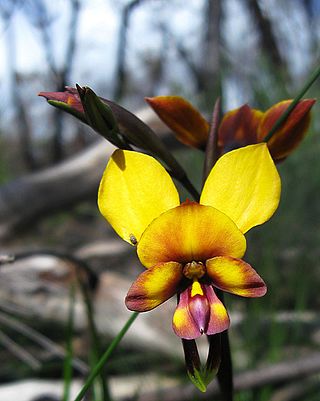
Diuris magnifica, commonly called the large pansy orchid, is a species of orchid which is endemic to the south-west of Western Australia. It has large, colourful flowers and is common in a narrow range near the coast around Perth, often occurring with the similar but smaller Diuris corymbosa.

Diuris concinna, commonly called the elegant donkey orchid, is a species of orchid which is endemic to the south-west of Western Australia. It has up to five linear leaves at its base and up to five pale yellow flowers with brown markings. It is found along the south coast, often growing in areas that are flooded in winter and flowering more prolifically after fire the previous summer.

Diuris heberlei, commonly known as Heberle's donkey orchid, is a species of orchid which is endemic to the south-west of Western Australia. It has three to five linear leaves at its base and up to four bright yellow flowers with a reddish brown border around the labellum callus. It is found along the south coast and is one of the last Diuris species to flower in Western Australia.
Diuris luteola, commonly called the northern doubletail, is a species of orchid which is endemic to Queensland. It has a single linear leaf at its base and up to six pale yellow flowers with a few brown markings. It grows in shallow, stony soil on tablelands in eastern parts of the state.

Diuris oporina, commonly called the autumn donkey orchid or northern white donkeys tails is a species of orchid that is endemic to Queensland. It has a single tapering, linear leaf at its base and up to ten white flowers with mauve to purple markings. It grows in the drier parts of the tablelands in Far North Queensland.

Diuris pulchella, commonly called the beautiful donkey orchid is a species of orchid that is endemic to the south-eastern part of the south-west of Western Australia. It has two or three leaves at its base and up to five bright yellow and mauve flowers described as "exquisite", "spectacular" and "attractive". It grows in shallow soil on granite outcrops near Esperance.
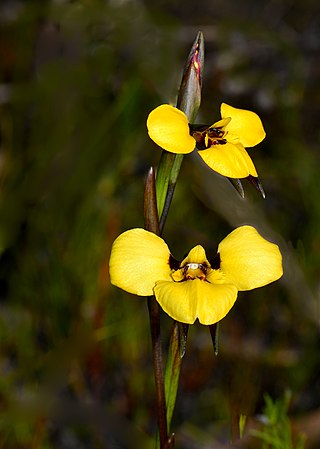
Diuris purdiei, commonly known as Purdie's donkey orchid, is a species of orchid that is endemic to the south-west of Western Australia. It has between five and ten leaves at its base and up to eight pale yellow flowers with reddish-brown or purplish markings. It mainly grows in swampy areas and only flowers after fires the previous summer.
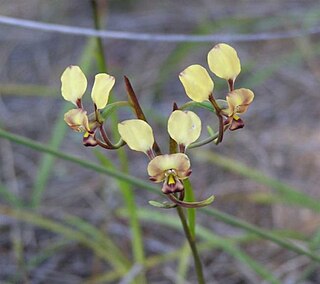
Diuris recurva, commonly called the mini donkey orchid is a species of orchid that is endemic to the south-west of Western Australia. It has one or two leaves at its base, up to six small pale yellow and brownish flowers and grows in winter-wet places between Badgingarra and Kalbarri.

Diuris tricolor, commonly known as the long-tailed donkey orchid or pine donkey orchid, is a species of orchid that is endemic to eastern Australia. It has up to three grass-like leaves and up to six orange-coloured to yellow flowers with white and purplish tints. The lateral sepals are unusually long.
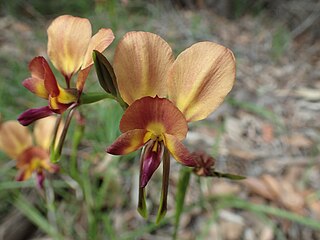
Diuris jonesii, commonly known as Dunsborough donkey orchid, is a species of orchid that is endemic to the south-west of Western Australia. It has large, yellow, brown and mauve flowers and is found in near-coastal areas between Dunsborough and Augusta.

Diuris brockmanii, commonly known as south coast donkey orchid, is a species of orchid that is endemic to the south-west of Western Australia. It has two or three linear leaves and a flowering stem with up to ten yellow flowers with reddish-brown markings.
Diuris brevifolia is a species of orchid that is endemic to South Australia. It usually has one or two grass-like leaves and a flowering stem with up to five bright yellow and reddish-brown flowers with purple stalks.

Diuris leopardina is a species of orchid that is endemic to south-eastern continental Australia. It has between two or three grass-like leaves of different lengths, and a flowering stem with up to five pale yellow to butter yellow flowers with reddish brown or purple marks and patterns, and leopard-like spots on the back.

Diuris suffusa, commonly known as mottled donkey orchid, is a species of orchid that is endemic to the south-west of Western Australia. It has two or three linear to lance-shaped leaves and up to seven cream-coloured to creamy-yellow flowers with light brown to reddish-brown markings.

















